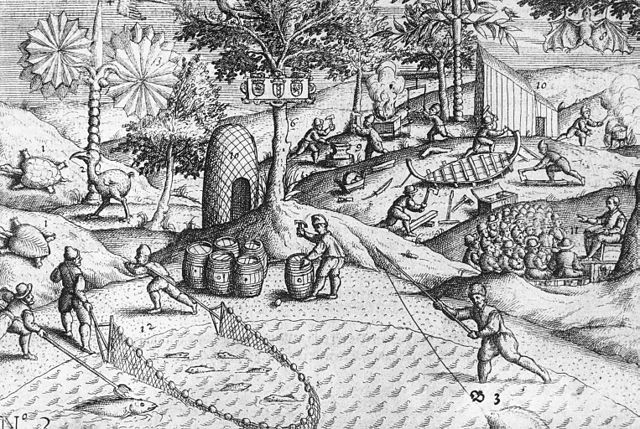The known and sometimes formally documented history of Mauritius begins with its possible discovery by Austronesians under the Austronesian expansion from pre-Han Taiwan, circa 1500 to 1000 BC, and then by Arabs,, followed by Portuguese and its appearance on European maps in the early 16th century. Mauritius was successively colonized by the Netherlands, France and Great Britain, and became independent on 12 March 1968.
Cantino planisphere (1502), Biblioteca Estense, Modena, Italy
Replica of an East Indiaman of the Dutch East India Company/United East Indies Company (VOC)
Parrot hunting on Mauritius by Johann Theodor de Bry, 1601
Copper engraving from Het Tweede Boeck showing Dutch activities on the shore of Mauritius during the 1598 voyage of Admiral Jacob van Neck, as well as the first published depictions of a dodo (2) and a broad-billed parrot (5), both now extinct. Johann Theodor de Bry, 1598
Mauritius, officially the Republic of Mauritius, is an island country in the Indian Ocean, about 2,000 kilometres off the southeastern coast of East Africa, east of Madagascar. It includes the main island, as well as Rodrigues, Agaléga, and St. Brandon. The islands of Mauritius and Rodrigues, along with nearby Réunion, are part of the Mascarene Islands. The main island of Mauritius, where the population is concentrated, hosts the capital and largest city, Port Louis. The country spans 2,040 square kilometres (790 sq mi) and has an exclusive economic zone covering 2,300,000 square kilometres.
Pedro Mascarenhas, Viceroy of Portuguese India and namesake of the Mascarene Islands.
Dutch activities on Mauritius, as well as the first published depiction of a dodo bird (2), 1601
The Battle of Grand Port between French and British naval forces, 20–27 August 1810
British forces seizing the Isle of France on 2 December 1810







